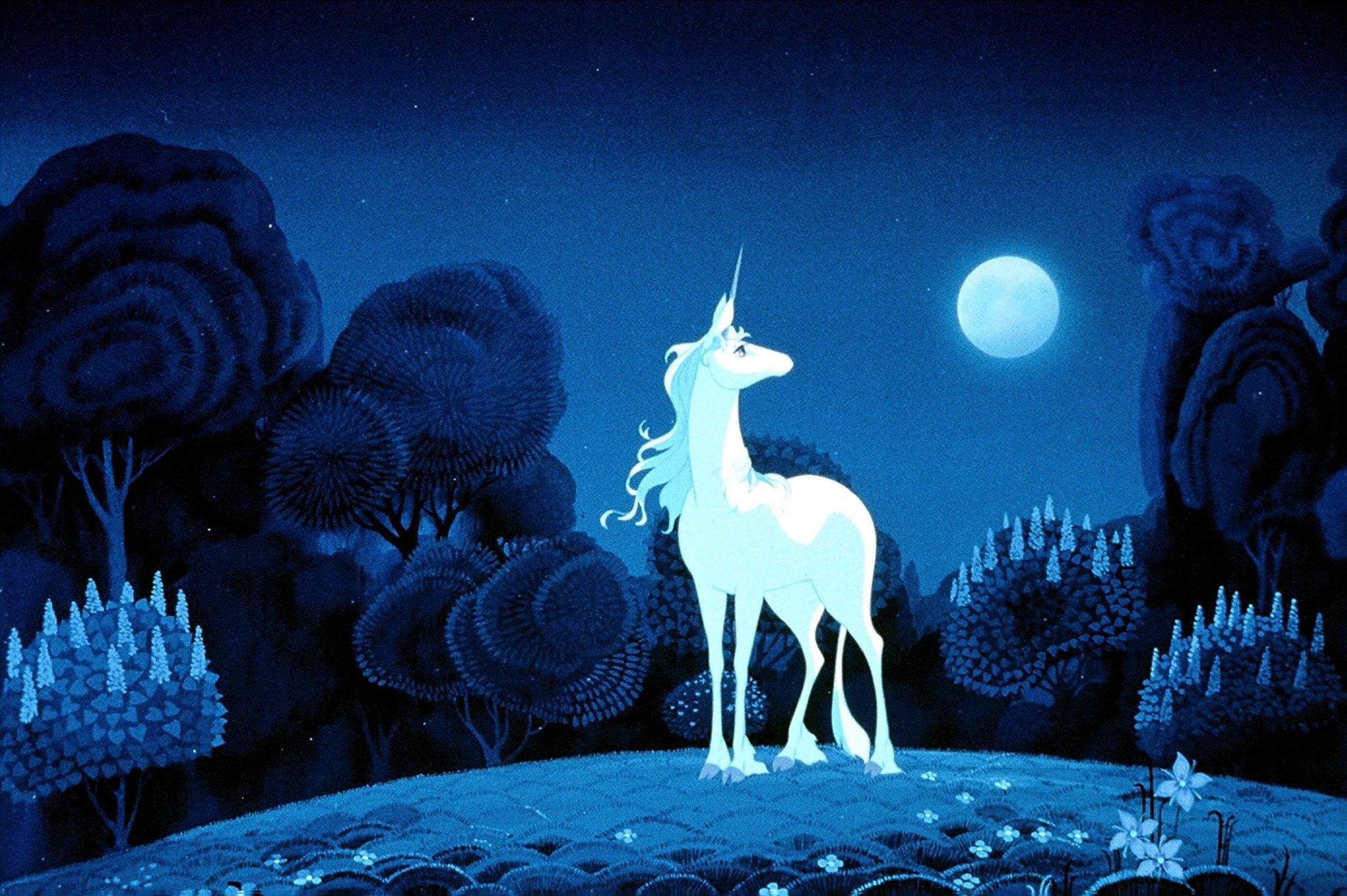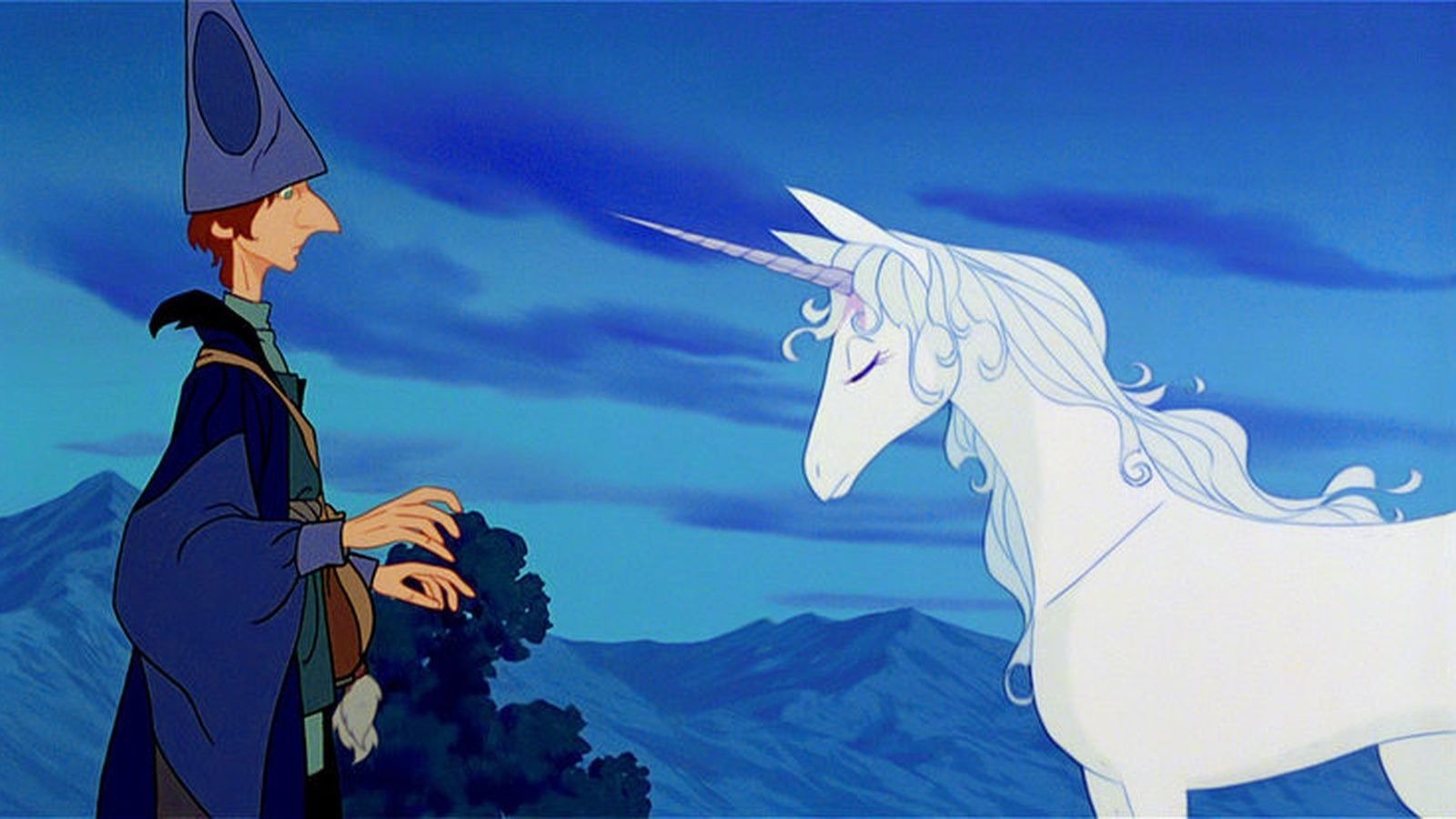Returning to the Forest: Nostalgia and Melancholy Upon Revisiting The Last Unicorn
I sat cross-legged on the carpeted floor next to my best friend Meggie, both of us unable to peel our eyes away from the 10-year-old 1992 Mitsubishi TV. We watched as the unicorn, majestic white mane flowing and big eyes sparkling, pranced across the pastoral landscape to the tune of “The Last Unicorn” by America. As the movie’s titular song swelled, sunlight streamed through the windows, soaking the living room of my childhood home in a magical glow akin to the light illuminating the unicorn’s pasture on screen. I would obsessively watch The Last Unicorn from ages six to eight, spellbound by the whimsical animation and its story of a lonely unicorn seeking community.
The Last Unicorn is a 1982 acid-trip of a film directed by Arthur Rankin Jr. and Jules Bass based on the 1968 novel of the same name by Peter S. Beagle. It’s a weird movie: There’s a murderous harpy that’s nightmare material, a voluptuous anthropomorphic tree and a couple random, out-of-place song breaks in act two. But there’s a reason it’s considered a cult classic by many, myself included—it’s visually stunning, full of lush, whimsical landscapes created by cel-animation reminiscent of classic Disney movies like Sleeping Beauty. It’s a masterfully hand-drawn work of animation. The Tokyo studio Topcraft animated The Last Unicorn and its core members would go on to help form Studio Ghibli. Miyazakian elements—idyllic environments, aspects of folklore, vibrant colors—are present throughout the film, though Hayao Miyazaki himself had nothing to do with its production.
I was captivated by this movie as a six-year-old growing up in the early 2000s, sucked into the off-beat fantasy world where the heroine doesn’t end up with the love interest but instead completes her quest restoring her community. Or maybe, as a horse girl, I just loved the unicorn voiced by Mia Farrow. But there was something about this movie I was particularly drawn to. I wasn’t watching, rewatching…then rewatching again… The Incredibles or Shark Tale, movies that were contemporary to the time (and great movies in their own right). Fantasy books and movies, like The Spiderwick Chronicles and Bridge to Terabithia, were my preferred genre of media. Many nights I would stay up hours past my bedtime, reading by the light of a small clip-on book light. My mom would notice the light shining from underneath my bedroom door when she came up to bed and tell me to put that book down and go to sleep. I even endeavored to write my own short fantasy story when I was in fourth grade, a tale about a girl who discovered she was a selkie—a shapeshifting sea creature of Celtic mythology.
What so intrigued me about fantasy as a child—and The Last Unicorn in particular—was that the narratives often involved the main character searching for community. My classmates wanted to play sports and chase each other at recess while I was more inclined to stick my nose in a book. But I blended in, not wanting to be the odd one out, playing on the grade school basketball team and half-heartedly participating in touch football games. I had friends, but reflecting on my childhood now at 24 years old, a distinct sense of loneliness permeates my memories. It wasn’t so much that I was alone, but rather that I knew I hadn’t quite found my people. I was lacking community, much like the unicorn.
Eighteen years after Meggie and I watched The Last Unicorn for the first time, we decided to honor our childhood and rewatch the movie that dominated our earliest memories. As the theme song played during the title sequence, I was overcome by a wave of nostalgia. I felt like a little girl again, thrown back to that sunlit living room and filled with wonder by the magical creatures on screen. But this time it wasn’t just a cute, coming-of-age road movie culminating in the unicorn finding her tribe. Halfway through the unicorn is turned into a human and confronts mortality, regret and loss for the first time. “For no unicorn was ever born who could regret. But now I do. I regret,” she says. Doubtless these mature themes had gone over my head when I was younger as I hadn’t yet experienced profound loss, regretted anything except maybe not picking up a fourth library book, or grappled with death anxiety. But nearly two decades had elapsed and I was older now. I’d grown up and the movie had grown up with me. Three of my grandparents had passed away, millions of people had succumbed to a deadly virus that shut down the world, I’d ended a significant relationship and lost touch with people who had once been my closest friends. The movie’s meaning had evolved beyond the surface-level understanding I had of it as a child. Instead of feeling hopeful at the end, I felt melancholic as the unicorn left her lover and the friends who had aided her on her journey to return to her forest.
Movies that transcend time, taking on different meanings at different points in our lives, help us to better understand our own personal development. The Last Unicorn has aged with me, growing beyond a hopeful tale of reassurance that I will find community. I found that community in my college friends and yet, the movie remained poignant beyond that initial understanding. Being able to revisit media we consumed early on in our lives and derive new meaning from it lets us remind ourselves of who we were and allows us to understand ourselves as unique, fluctuating individuals instead of stagnate characters. Like the unicorn, we return to our forest flush with knowledge and the experiences we’ve accumulated along the way.




Amelia is a writer, film enthusiast and die-hard Wong Kar-wai fan based in Brooklyn. Find her on IG @ameliaalangas.